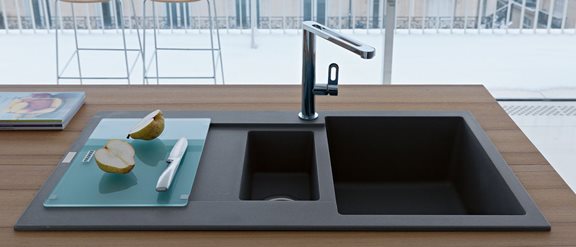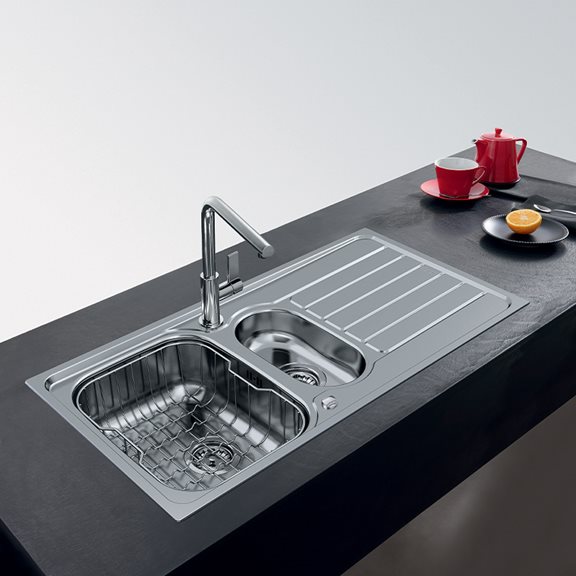How do you unblock your kitchen sink?
Discover all the tips, techniques and methods – including the simplest – to unblock your sink or washbasin.
How do you unblock your kitchen sink?
Is your kitchen sink blocked? This is a common problem. Because you often use your sink to rinse your plates and cutlery, to wash your dishes, clean your vegetables, etc. Over time, bits of soap, grease, organic waste and food residues can accumulate in the pipes under the sink and form a blockage. This prevents the water from draining as it should, and it can even stagnate on the surface of the sink. If you detect any unpleasant smells, that could indicate there is a blockage.
What’s the solution?
The technique and the product(s) you should use will depend on how ‘serious’ the situation is. But it’s not a time to panic: mostly, you can easily unblock your sink or washbasin yourself. So here we will look at four scenarios and offer you helpful advice for each one:
- a small blockage
- a large blockage
- when the problem is beyond the siphon
- when the problem is not even in your home.
A small blockage, easy to solve!
If the blockage is fairly limited and the waste is found near the surface of the sink or washbasin, you can choose from three solutions: two possibilities to unblock in 5 minutes, and one that will take from 30 minutes to a few hours at least.
1. Boiling water
The simplest solution – and the cheapest – is to boil a pan of water (two litres will be enough) and to pour it slowly and carefully into the sink to clean the drain pipes by dissolving any particles there. You can also add a little dishwashing liquid, which will have a degreasing effect. But what if this fails to work immediately and the pipes are still blocked? Repeat the operation (several times) before trying something different.
2. The plunger
Here is a traditional method that will oblige you to use some energy and muscles, but it will help you to unblock your sink in under 5 minutes:
- Block the overflow with a wet cloth, to stop the air from escaping from this hole;
- Place the plunger flat over the drain (this is the metal part located over the drain hole);
- Run a little water to cover the plunger’s rubber;
- Apply pressure to the plunger to make it adhere to the bottom, then create air flows by using successive short movements. This back-and-forth movement will force water to circulate in the pipe, increasing the pressure and dislodging the blockage.
Here too, you may have to repeat the operation until the water flows normally.
3. Bicarbonate, vinegar and salt
The third solution is a traditional remedy whose ingredients are readily available... in your kitchen cupboard. It’s a highly effective mixture of 200 g baking soda, 20 cl white vinegar and 200 g coarse salt. Pour this mixture into the blocked sink and leave for half an hour. Then pour in 1 litre of boiling water to thoroughly clean the sink and drains. If the remedy doesn’t work, follow the same procedure, but leave the mixture in the pipes overnight before rinsing.
A large blockage? Tackle the siphon.
Is a bigger blockage stopping the water from draining correctly? If so, try disassembling the siphon. This tube – which has a U curve or S curve is situated beneath the drain hole and connects the sink to the drainage system.
This mechanism is always filled with a little water, to prevent the rising of any unpleasant smells as well as insects or rodents. So you will need to place a bucket or bowl under the siphon. Wear gloves to protect your hands and unscrew the siphon by hand, to stop the waste from escaping. After you have removed the blockage, you should take the opportunity to clean the siphon with hot water and soap, before screwing everything up again. Reassemble carefully and don’t forget to replace the joint, to prevent any leaks.
System D
You can also clean the pipes with an iron-wire coat hanger, which you have bent into a hook shape. This tool can be used to latch onto the blockage and get rid of it. Although this system can be effective, you must be careful not to damage the pipes. So it’s better to practise using the hanger, before trying this operation.
What about chemical products?
Some products work really well and will quickly unblock your sink. But you should still use them with care and in small quantities. Because these products include corrosive substances that can harm your health and the environment, and they can cause damage to your installation and sanitary fittings.
Get professional help
If, despite all your efforts, your bathroom sink is still blocked, it is likely that the draining blockage is located beyond the siphon. You should call in a qualified plumber, who will carry out a proper unblocking, one that is both clean and safe. Plumbers have the right equipment – e.g. a drain snake and/or a high-pressure cleaner – to locate the blockage. They can then use the appropriate means to remove it, depending on its composition (organic waste, scale, or sometimes an object).
What is a drain snake?
A drain snake is not a living animal, you’ll be happy to hear! It’s a metal tool that is long and flexible (often up to trois metres long) and has a drill bit at the end. The plumber inserts the drain snake into the pipes and breaks up the blockage using the drill bit. This allows the water to move again through the piping, with no need for disassembly.
A plumber can achieve the same result with a high-pressure cleaner that comes with an unblocking kit. The cleaner’s tube is introduced into the blocked pipes and water is sent down them at high pressure to complete the cleaning.
Who should pay the plumber?
The plumber’s work should be paid by the tenant, unless it can be proved that the obstruction is due to outdated fittings or poor maintenance of these fittings before the tenant moved into the building. In the latter case, the owner must pay the bill.
The problem is elsewhere
In the final scenario, the blockage is not in your home but located in drain pipes further away. This will be evident if you notice that the kitchen sink – as well as the bathroom washbasin and maybe even the drains of the bathtub and/or shower – are blocked. So what can you do in this situation?
- If you live in a block of apartments: ask your neighbours if they have the same problem. If so, contact the managing agent or the manager of the co-owned property, to get them to take the necessary measures.
- If you live in an individual house, check to see if an outside pipe is blocked by fallen leaves, moss, twigs, etc. If any blockage is located on your property, you should call in a professional or contact the local authorities.
Prevention is better than cure
You can also stop blockages from forming through simple, easy and quick cleaning. Here are a few tips for regular maintenance:
- Pour boiling water, to which you have added washing soda, twice a month into the sinks and washbasins, then rinse well.
- Unscrew the siphon now and again, to empty and clean it.
- Pour a tablespoon of coffee grounds into the pipes once a month, to stop them getting blocked and to remove any bad smells. However, this tip is only suitable for prevention: don’t use it for unblocking, as you could run the risk of making the problem worse!




